Abstract
This study was performed to analyze the relationship among sebum · hydration content of the skin and nutritional intake, serum antioxidant minerals and antioxidant enzymes, and lipid peroxide concentration in 50 female subjects in their 20s. The skin type was divided into Dry Skin, Mixed Skin, and Oily Skin, and the dry skin group was 14%, the mixed skin group was 56%, and the oily skin group was 30% of all subjects. The average age of the subjects was 20.54 ± 1.43 years and BMI was 20.66. The average sebum content in each group was in the order of T-zone>forehead>chin>cheek. In case of the T-zone, a significant difference between the dry skin group and the oily skin group was observed, suggesting that the area is most sensitive to sebum content by skin type. Significant differences were not observed in energy and nutrient intakes by skin type. Serum concentrations of antioxidant minerals such as copper, manganese, zinc and selenium were not significantly different among the groups, but the dry skin group tended to be higher than the oily skin group. Serum catalase was significantly higher in the oily skin group (P < 0.05), and MDA was significantly higher in the mixed skin group (P < 0.05). The hydration of the cheek and serum zinc showed a negative correlation, and the sebum content of the cheek and GPx showed a significant negative correlation. The hydration of the forehead and serum copper showed a significant negative correlation, and the hydration of the forehead and GPx showed a significant positive correlation. The hydration of the chin and serum SOD showed a significant positive correlation. With these results, it is considered that the basic condition of nutritional status can affect the skin health.
The skin protects the body from mechanical damage, microbial invasion, and radiation or UV light, as a barrier between the internal part of the body and the external environment. Thus, the skin plays an important role in the maintenance of homeostasis of the body by minimizing the moisture loss and regulating the temperature [1]. Also, the skin is the outermost protective layer of the body which is continuously exposed to external stimulants such as environmental pollutants or ozone, radiation, UV light, and thus has been greatly under stress due to oxidative damages. Reactive oxygens aggressive to the cells are continuously produced in the body while the life goes on and they become the main culprit of the cell aging [2,3]. Therefore, the roles of antioxidant for preventing the oxidation of skin cells have been concerned to maintain healthy and beautiful skin [4], and the development of products mainly applicable on the skin has been highlighted [5].
In the past, skin care and health management was treated by emphasizing skin troubles but in the present, the preventive program has come into the spotlight that integrates detailed skin analysis through skin care instruments, professional counseling, individualized care & treatment, and dietary habits & exercise lifestyle [6,7]. In case of Japanese women, Koyama et al. [8] reported that collagen peptide intake increased the absorption rate of water of stratum corneum. However, skin health-related domestic studies performed up to the present time are mostly about the influences of dietary habits and lifestyle on the skin [9-12]. Because problems related to skin health and skin condition can originate from the internal factors due to meals, it is necessary to study nutritional factors that affects skin condition. Thus, this study was performed to analyze the relationship between skin condition and antioxidant nutrition status and antioxidant activity through nutritional intake and biochemical analysis of the blood by skin type in female college students, and thus to utilize the study results as basic data in the skin care and health area.
This study was performed from March to April of the 2009 in 50 healthy female college students of S university located in Seoul, who were instructed for study contents and purposes and then signed for consent. For accurate measurements of skin condition, the degree of hydration and sebum content of the subjects were measured at constant temperature and humidity condition (room temperature: 18.0℃, humidity: 55.5%) after 2 hours of stabilization period following the cleansing step. The hydration of the skin was measured and recorded by contacting the probe of Corneometer (MPA-580, Germany) on the skin surface of forehead, cheek, and chin. The subjects were divided into the following study groups based on the standards of sebumeter SM815 [13] considering both sebum content and hydration. Oily Skin was defined as over 70 µg/cm2 of average sebum content in forehead, nose, cheek, and chin, and over 50 AU of hydration in forehead, cheek, and chin; Dry skin was defined as less than 69 µg/cm2 of average sebum content in forehead, nose, cheek, and chin, and less than 49 AU of hydration in forehead, cheek, and chin. Mixed skin was defined as the cases with sufficient hydration (over 50 AU) and lower sebum content (less than 69 µg/cm2) or the cases with sufficient sebum content (over 70 µg/cm2) and lower hydration (less than 49 AU).
Nutrient intakes of the subjects were obtained through the measurement of food intake by 24-hour recall method (1day) and analyzed by CAN-program.
The height and weight of the subjects were measured by automatic height/weight measurement system (G-TECH International: GL-150), and body fat mass, percent body fat, body mass index (BMI), soft lean mass, and waist/hip ratio(WHR) were measured by Inbody330 (BIA)/Biospace Co., Ltd.
Fasting serum concentrations of Se, Mn, Cu and Zn were measured using pyrolytic coated THGA tube (L'vov Platform type) and Ar gas (99.99%) and analyzed by Perkin-Elmer's AAS 4110ZL [14].
The SOD activity was obtained, on the basis of the method of Floh, by measuring the degree of inhibition on the following reaction in which superoxide radical produced from xanthine by the action of xanthine oxidase reacts with I.N.T(2-[4-iodopheny]-3-[4-introphenol]-5phenyl-tetrazolium chloride) to form formazan dye (Cobas MIRA, Roche, Switzerland). GPx was analyzed by measuring the degree of reducing absorption of NADPH from 340nm when glutathione is reduced by GR (Glutathione reductase) and NADPH using a UV method based on Pagila and Valentine method (Cobas MIRA. Roche, Switzerland). The catalase activity was measured by using a Bioxytech catalase-520 Kit (OxisResearch, USA) and analyzed by UV 1700 spectrophotometer (Shimazdy, Japan).
MDA, a lipid peroxide, was measured using HP 8452A (Hewlett Packard America), and serum TAS was measured using a TAS Kit (RANDOX Laboratories Ltd., Ardmore, UK) and analyzed by Hitachi 7150.
All data resulted from this study were statistically analyzed by using a SAS (Statistic Application System) Package and were presented as mean and standard deviation by skin type. Sebum and hydration groups were analyzed using Kruskal-Wallis Test among non-parametric statistics, and the relationship among sebum · hydration and body composition, biochemical data of the serum, and dietary intake was examined through Pearson's correlation analysis.
The study subjects were divided into groups by skin type (Dry Skin, Mixed Skin, Oily Skin) and measured for anthropometric data, which were not significantly different in all items (Table 1). The dry skin group was 14% (n = 7) of all subjects, the mixed skin group was 56% (n = 28), and the oily skin group was 30% (n = 15). The average age of the subjects was 20.54 ± 1.43 years and the average height, weight and BMI was 159.13 ± 4.32, 53.96 ± 5.82, and 20.66 ± 1.98, respectively. Body fat mass was 16.81 ± 6.15 kg in the mixed skin group, which tended to be higher than 15.33 ± 2.40 in the dry skin group and 14.61 ± 3.05 in the oily skin group.
The sebum content of each skin surface area by skin type is shown in Table 2. The average sebum content in each group was in the order of T-zone > forehead > chin > cheek. In case of the T-zone, a significant difference between the dry skin group and the oily skin group was observed, suggesting that the area is most sensitive to sebum content by skin type.
As shown in Table 3, the average calorie intake of all subjects was 2,183.6 ± 507.7 kcal, which was about 104% of EAR of the KDRIs (2005) [15], and no significant difference was observed among groups. Fat intake in the dry skin group was 47.5 ± 16.4 g, which was higher than 36.8 ± 16.5 g in the mixed skin group and 37.4 ± 16.7 g in the oily skin group. The average protein intake of all subjects was 180% of the KDRIs (2005), and that of the dry skin group was 86.9 ± 32.6 g, which was rather higher than 78.5 ± 27.7 g in the mixed skin group and 79.5 ± 26.9 g in the oily skin group. Cholesterol intake was 292.7 ± 124.5 mg in the dry skin group, which tended to be higher than 240.6 ± 160.9 mg in the mixed skin group and 240.9 ± 137.7 mg in the oily skin group. The intake of saturated fatty acid and monounsaturated fatty acid was 9.1 ± 3.9 g and 8.5 ± 4.1 g, respectively, in the dry skin group, which tended to be higher than those in the mixed skin group and the oily skin group. The fiber intake was 150% of the KDRIs (2005), and significant differences were not observed among groups. The intakes of several vitamins were in the range of 130~180% of the KDRIs (2005), and the dry skin group showed rather higher intakes in vitamins except vitamin C than the mixed and oily skin groups, and significant differences were not observed among groups. The nutrients showing lower intake levels than the standards of the KDRIs (2005) were calcium (92.5%), potassium (71.5%), and folate (75.9%).
1) Serum copper, manganese, zinc, and selenium concentrations
Serum levels of antioxidant minerals by skin type are shown in Table 4. The concentrations of antioxidant minerals such as copper, manganese, zinc and selenium were not significantly different among groups. Concentrations of copper, manganese, zinc, and selenium in the dry skin group were higher than those in the oily skin group.
Serum antioxidant enzymes and MDA content by skin type are shown in Table 5. Antioxidant enzymes such as SOD and GPx, and the total antioxidant status (TAS) were not significantly different among study groups. The catalase level was 49.40 ± 35.20 kU/L in the dry skin group, which was significantly lower than 63.00 ± 39.48 kU/L in the oily skin group (P < 0.05). SOD was 1.57 ± 0.57 U/mL in the dry skin group, which was higher than 1.87 ± 0.63 U/mL in the oily skin group. The concentration of malondialdehydes (MDA), a product of peroxidation showing the degree of serum lipid peroxidation due to oxidative stress, was 1.76 ± 0.63 µmol/L in the mixed skin group, which was significantly higher than 1.55 ± 0.23 µmol/L in the dry skin group and 1.47 ± 0.59 µmol/L in the oily skin group (P < 0.05).
The correlation analysis between the hydration content of facial areas and dietary intake is shown in Table 6.
A significant negative correlation was observed only in the hydration of the cheek and zinc intake (r = -0.411, P < 0.01). As shown in Table 7, in case of correlations among sebum content in the facial area and serum antioxidant minerals and antioxidant enzymes, a significant negative correlation was observed in the antioxidant enzyme GPx and the sebum content of the cheek (r = -0.292, P < 0.05). The correlations among the hydration in the facial area and serum antioxidant minerals and antioxidant enzymes are shown in Table 8. The hydration of the forehead was negatively correlated with serum copper significantly (r = -0.307, P < 0.05), and positively correlated with GPx significantly (r = 0.367, P < 0.01). The hydration of the cheek and serum zinc showed a significant negative correlation (r = -0.435, P < 0.01), and the hydration of the chin and serum SOD showed a significant positive correlation (r = 0.333, P < 0.05).
This study was performed to investigate the antioxidant nutrition status by skin type through nutritional intake and serum analysis of antioxidant minerals and antioxidant enzymes by skin type in female college students. The dry skin group was 14% of all of 50 subjects, the mixed skin group was 56%, and the oily skin group was 30%. Compared to the study of Hong [12] (dry; 30%, normal; 50%, oily; 20%), the distribution of the dry skin group in this study was low and that of the oily skin group was rather high, and that of the mixed skin group was similar. The average age of the subjects was 20.5 ± 1.4 years, and the average BMI was 20.7 ± 2.0 kg/m2, which was slightly lower than the average value for adults over 20s, 22 kg/m2, presented by the KNS in 2005. Percent of body fat, WHR and soft lean mass were not significantly different by skin type. However, body fat mass in the mixed skin group was 16.8 ± 6.2 kg, which was higher than 15.3 ± 2.4 kg and 14.6 ± 3.1 kg in the dry skin group and the oily skin group, respectively, and slightly different from the result reported by Choi [15] in which higher BMI and body fat mass were observed in the oily skin group. When dividing the skin type by considering both hydration and sebum content, the difference in the sebum content was significantly observed in the T-zone between the dry skin group and oily skin group. Thus it is considered that the T-zone can represent the sebum content of the skin when measuring the sebum content only in particular areas. The average daily energy intake of the subjects was 2183.6 ± 507.7 kcal, which was about 104% of the recommended 2,100 kcal of the KDRIs (2005) [16] and no significant difference was observed among groups. Fat, cholesterol, saturated, and mono unsaturated fatty acid intake in the dry skin group was tended to be higher than in the mixed skin group and in the oily skin group. Park et al. [17] in the study for women in Gwangju region, reported that the fat intake was slightly lower in the oily skin group compared to the dry skin group. This suggests that individuals with dry skin might intentionally increase their fat intake. Cosgrove et al. [18] observed that higher intakes of linoleic acid were associated with better skin-aging appearance. The human skin is the most active organ among all tissues in the body and maintains the epidermal homeostasis by continuously forming new epidermal cells and repeating differentiation and exfoliation [19]. In particular, the lipid biosynthesis of the epidermis is the critical process of forming the skin barrier [20], and thus the importance of desirable fat intake has been emphasized as a fundamental way of managing dry skin. The CPF (Carbohydrate : Protein : Fat) ratio was 65 : 16 : 19, which is in the recommended range for adults over 20 years, 55~77 : 7~20 : 15~25. The fiber intake was 148% of the KDRIs(2005) [16] showing sufficient intake for dietary fiber. In case of zinc, the intake exceeded the recommended level in all three groups. The excessive intake of zinc interferes with the absorption of copper, possibly leading to copper deficiency and decreased HDL-cholesterol level, delayed would healing, skin dryness, and alopecia, and thus careful intake is needed [21]. The intakes of several vitamins were in the range of 130~180% of the recommended KDRIs (2005) [16], and the dry skin group showed rather higher intakes in vitamins except vitamin C than the mixed and oily skin groups, and significant differences were not observed among groups. The nutrients showing lower intake levels than recommended by the KDRIs (2005) were calcium (93%), potassium (72%), and folate (76%). In case of serum antioxidant enzymes, only the catalase content showed significant difference, with significantly higher content in the oily skin group than in the dry skin group and mixed skin groups (P < 0.05). SOD was 1.87 ± 0.63 U/mL in the oily skin group, which was higher than 1.57 ± 0.56 U/mL in the dry skin group. Superoxide anion (O2-) is generated during the oxidative phosphorylation of the cell, particularly in large amounts during the lipid peroxidation, which damages the cell membrane [22]. Also, it has been reported that superoxide anion is activated to an uncoupling protein to increase the proton permeability, which is undesirable to cell metabolism [23]. There is a two-step mechanism in the body to eliminate superoxide anions. The first step involves SOD, in which O2- is converted to H2O2, and catalase metabolizes H2O2 into H2O, in the antioxidant action. Thus, in relation to the result of this study that catalase and SOD contents were higher in the oily skin group with sufficient hydration and sebum contents, it is considered that the regulation of internal antioxidant defense mechanism can influence the health of the skin. Catalase is particularly decreased in the aging skin and thus presented as an antioxidant enzyme that has an important role in the skin aging process [24]. The concentration of malondialdehydes (MDA), a product of peroxidation showing the degree of serum lipid peroxidation due to oxidative stress, was 1.76 ± 0.63 µmol/L in the mixed skin group, which was significantly higher than 1.55 ± 0.23 µmol/L in the dry skin group and 1.47 ± 0.59 µmol/L in the oily skin group (P < 0.05). This is similar to the result reported by Bae [25] in which the average MDA concentration of women in 20s resided in Seoul was 1.63 ± 0.59 µmol/L, and also similar to the result by Han [26] in which the MDA concentration in the mixed skin was higher then those in the dry skin group and oily skin group. Dry skin is also known as xerosis, which appears as the moisture content in the stratum corneum is decreased, and if getting worse, the skin becomes weak and vulnerable to infection. The stratum corneum contains 10~20% of water from natural moisturizing factors, and if the moisture level becomes below 10%, the corneous tissue becomes thick and the skin texture becomes rough, and the aging accelerates. The extracellular lipids of the stratum corneum function as a water protection film, of which ceramide is over 40%, fatty acids is about 25%, and cholesterol is about 20%. Thus it has been known that if these three compositions change, then the function of protective film can be defected [27]. For possible influence of the difference in nutritional intake and dietary habit on the skin health, the correlation analysis between the hydration content of facial areas and dietary intake showed that a negative correlation was observed in the hydration of the cheek and zinc intake (r = -0.411, P < 0.01). Kim et al. [28] reported that skin evenness had negative correlations with zinc intake. Zinc has been known to protect the thiol group in the skin cell and thus to protect the skin cell membrane from oxidative damage by UV light, but excessive zinc intake for skin protection is not desirable for skin moisturizing. The correlation analysis among sebum content, serum antioxidant minerals and antioxidant enzymes, and MDA showed that a significant negative correlation was observed in the antioxidant enzyme GPx and the sebum content of the cheek (r = -0.292, P < 0.05). Sebum content of the cheek was decreased when serum GPx was high, and it is thus considered that lipid oxidation in the skin can be possibly prevented through complementary action with moisture. By combining the results that the hydration of the forehead and serum copper showed a significant negative correlation and the hydration of the cheek and serum zinc showed a significant negative correlation, and the results that the hydration of the forehead and GPx showed a significant positive correlation and the hydration of the chin and serum SOD also showed a significant positive correlation, it is thought that the activity of antioxidant enzymes rather than the serum mineral concentrations has positive influence on the hydration content of the fracial area. Therefore, if antioxidant enzymes such as GPx and SOD are used in cosmetics or functional foods, it can be possibly delay or prevent skin aging by maintaining the moisture level of the face. Skin health status appears to be affected by the interaction of the number of nutrients, not by single nutrient. By considering that the key concept of the quality of life recently is to provide sufficient nutrition from inside and outside the body to maintain skin health and beauty, it should be noted that the functions of nutrients as nutricosmeceuticals are being expanded. This study has a limitation in which the results came from a small number of subjects, and 1-day food intake record. Thus it is necessary to perform a large-scale study with lots of participants in the future to figure out the antioxidant defensive system of the skin that is possibly regulated by dietary changes.
References
1. Boelsma E, Hendriks HFJ, Roza L. Nutritional skin care: health effects of micronutrients and fatty acids. Am J Clin Nutr. 2001; 73:853–864. PMID: 11333837.

2. Jackson MJ. Free radicals in skin and muscle: damaging agents or signals for adaptation? Proc Nutr Soc. 1999; 58:673–676. PMID: 10604201.

3. Rhie GE, Shin MH, Seo JY, Choi WW, Cho KH, Kim KH, Park KC, Eun HC, Chung JH. Aging-and photoaging-dependent changes of enzymic and nonenzymic antioxidants in the epidermis and dermis of human skin in vivo. J Invest Dermatol. 2001; 117:1212–1217. PMID: 11710935.
4. Bae HS, Cho YH, KIm JY, Ahn HS. Comparison of nutrient intake and antioxidant status in female college students by skin types. Korean Journal of Community Nutrition. 2006; 11:63–71.
5. Bogdan Allemann BI, Baumann L. Antioxidants used in skin care formulations. Skin Therapy Lett. 2008; 13:5–8. PMID: 18839043.
6. Jeon SI. Overcoming skin problems. 2007. Seoul: Academya Publishing Co..
7. Giacomoni PU. Advancement in skin aging: the future cosmeceuticals. Clin Dermatol. 2008; 26:364–366. PMID: 18691516.

8. Koyama Y, Sakashita A, Kuwaba K, Kusubata M. Effects of oral ingestion of collagen peptide on the skin. J Fragr. 2006; 6:82–85.
9. Choi G, Lee SH, Na YS. Effects of the health behavior on skin health in female university students. Journal of the Korean Society of Cosmetology. 2003; 9:63–70.
10. Kim HJ. Skin health condition related factors and evaluation index of women in early twenties. Journal of the Korean Society of Cosmetology. 2005; 11:210–216.
11. Seo DH, Park GS, Shin YJ. The dietary habits and preference of foods on skin types of woman college students. Korean Journal of Food Culture. 2005; 20:15–20.
12. Hong JI, Kim JD. Health state of women's skin and relevant life style. Journal of the Korean Society of Cosmetology. 2007; 13:964–975.
13. Soh BH. The application of non-invasive skin bioengineering devices for measuring the skin physiology(I). Korean Edu J Aesthetics. 2003; 1:177–184.
14. Erickson SP, McHalsky ML, Rabinow BE, Kronholm KG, Arceo CS, Weltzer JA, Ayd SW. Sampling and analysis techniques for monitoring serum for trace elements. Clin Chem. 1986; 32:1350–1356. PMID: 3719945.
15. Choi MS. Body composition change and skin type in dietary habits of university students [master's thesis]. 2005. Daegu: Public Health Deagu Haany University.
16. The Korean Nutrition Society. Dietary reference intakes for Koreans. 2005. Seoul: The Korean Nutrition Society.
17. Park YS, Rou F, Jaegal S. Relationship between nutritional status and facial sebum content of young women. Korean Journal of Community Nutrition. 2006; 11:587–597.
18. Cosgrove MC, Franco OH, Granger SP, Murray PG, Mayes AE. Dietary nutrient intakes and skin-aging appearance among middle-aged American women. Am J Clin Nutr. 2007; 86:1225–1231. PMID: 17921406.

19. Park CS. Epidermal homeostasis and dry skin management. Journal of the Society of Cosmetic Scientists of Korea. 2008; 34:1–8.
20. Pappas A, Anthonavage M, Gordon JS. Metabolic fate and selective utilization of major fatty acids in human sebaceous gland. J Invest Dermatol. 2002; 118:164–171. PMID: 11851890.

21. Walsh CT, Sandstead HH, Prasad AS, Newberne PM, Fraker PJ. Zinc: health effect and research priorities for the 1990s. Environ Health Perspect. 1994; 102:5–46. PMID: 7925188.
22. Seo YM. Effect of superoxide dismutase on oxidative stress of reactive oxygen species in cultured human skin melanocyte [master's thesis]. 2007. Iksan: Wonkwang Health Science University.
23. Hornig-Do HT, Kleist-Retzow JC, Lanz K, Wickenhauser C, Kudin AP, Kunz WS, Wiesner RJ, Schauen M. Human epidermal keratinocytes accumulate superoxide due to low activity of Mn-SOD, leading to mitochondrial functional impairment. J Invest Dermatol. 2007; 127:1084–1093. PMID: 17185981.

24. Seo JY, Cho KH, Eun HC, Chung JH. Skin aging from phenotype to mechanism. Korean Journal of Investigative Dermatology. 2001; 8:187–194.
25. Bae HS. Dietary intake, serum lipids, iron index and antioxidant status by percent body fat of young females. Korean Journal of Community Nutrition. 2008; 13:323–333.
26. Han YR. Study on the correlationship among women's hydration of the skin anti-oxidant & generation of sebum [master's thesis]. 2005. Seoul: Sung-shin Women's University.
27. Park CS. Skin barrier and beauty foods. Food Science and Industry. 2007; 40:19–26.
28. Kim MY, Cho KD, Baek OH, Lee BH. Effects of body composition, nutrient intakes and biochemical indices on skin health status of female university students with sensitive skin. Korean Journal of Food Culture. 2008; 23:258–267.
Table 6
Correlation coefficient between hydration and daily energy and nutrient intake of the subjects
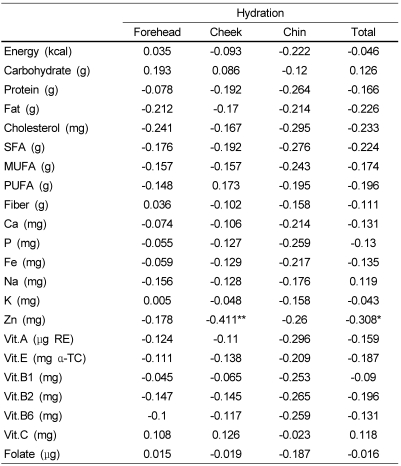




 PDF
PDF ePub
ePub Citation
Citation Print
Print


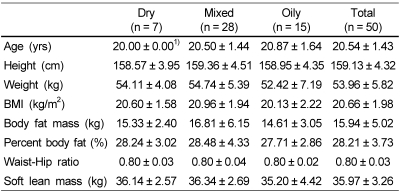
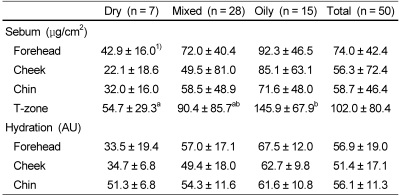


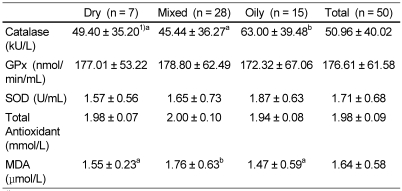
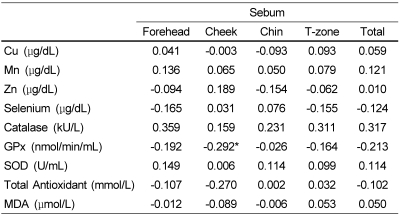
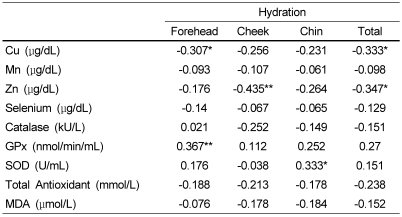
 XML Download
XML Download